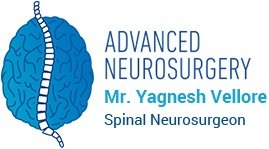Cervical Disc Arthroplasty
Cervical disc replacement is an alternative to anterior cervical discectomy and fusion. It involves the replacement of the degenerated, herniated disc, in the neck region, by an artificial disc. This provides the benefit of maintaining the natural flexibility and motion of the neck, at the level of the replaced disc. It also allows equal pressure distribution in the cervical spine, between the replaced artificial disc and the discs present above and below it, preventing adjacent segment degeneration. Adjacent segment degeneration is a problem associated with fusion of the vertebrae that results in degeneration of the intervertebral discs, above and below the fused vertebrae.
Patients experiencing extreme neck and arm pain with tingling sensation, numbness and weakness in the arms are recommended surgery for cervical disc replacement when the non-surgical treatment fails to be beneficial or in the presence of radiculopathy (pressure on the spinal nerves) and myelopathy (pressure on the spinal cord). However, it is avoided in patients with cervical spine instability, considerable facet joint damage or infection.
Artificial discs for cervical disc replacement are available in various designs. They usually consist of two metallic endplates with a plastic spacer in between. The endplates can move over the spacer, like the movement of the vertebral body over the disc. Artificial discs with metal on metal design are also available. The artificial disc is fixed to the vertebral body with screws; the endplates of a few artificial discs have spikes which help in attachment of the disc to the vertebral body.
Before the surgery
Before the surgery, medical history and various diagnostic tests such as X-rays or other imaging tests are used to ascertain the spinal condition causing pain and the other associated symptoms. The current health status of the patient is evaluated through blood tests and other specialized tests, for diseases such as diabetes and heart disease. Based on the medical condition and the general health of the patient, the ideal patients for cervical disc replacement are selected.
The surgeon explains the surgery, the type of disc to be used and its benefits along with the possible risks to the patient. A general health clearance is obtained from the patient’s general practitioner for the surgery.
Procedure
The patient is administered general anaesthesia and placed face up on the operating table. An incision is made on the front side of the neck, at the level of the damaged cervical disc. The positioning of the incision is confirmed by real time images from intra-operative fluoroscopy. Moreover, the incision is made so that the scar is hidden in the natural skin folds of the neck, after healing. The muscles and the soft tissues are moved to the side to expose the cervical spine. The whole degenerated disc is removed by discectomy and the surface of the vertebral body in the disc space is prepared to receive the artificial disc. The area around the spinal cord and spinal nerves is then completely cleaned and decompressed by carefully removing any soft tissue, bony outgrowths (osteophytes) or thickened ligaments with micro-surgical instruments. The artificial disc is inserted in the disc space and the endplates of the artificial disc are fixed to the surface of the vertebral body guided by the images from intra-operative fluoroscopy. The proper position and alignment of the implanted disc is finally confirmed by fluoroscopy and the muscles and the soft tissue are repositioned. The incision is then closed.
After the surgery
After the surgery, the vital signs of the patient are closely monitored and special care is taken by the nurses and medical staff to manage the post-operative pain. Some discomfort around the incision and occasional muscle spasms in the neck can occur and will resolve in a few weeks after the surgery.
Post-operative Care
- The incision should be kept clean and dry till it heals completely. Care should be taken to cover it properly while bathing. Swimming and hot tubs should be completely avoided.
- Medications should be taken regularly, as prescribed.
- Physical therapy should be taken, as advised.
- Lifting anything heavier than a shoe should be avoided.
- A healthy lifestyle should be followed to promote healing. This may include healthy nutritious food, ample rest and abstinence from smoking. Walking is also encouraged.
- Driving should be avoided. However, a ride in the car, for small distances, is allowed.
Risk and Complications
The risks and complications of the surgery may include infection, bleeding, nerve injury, or spinal cord injury. Complications due to general anaesthesia may also occur.
Contact the surgeon at the earliest on observation of any of the following symptoms:
- Fever ≥ 101°F
- Increase in redness, swelling or pain at the incision site
- Visible significant change in the volume, colour or smell of the incision drainage fluid
- Loss of bladder or bowel function: This is a medical emergency and the surgeon should be contacted immediately
- Numbness in the genital area
Contact your surgeon for any unanswered queries on cervical disc replacement.

